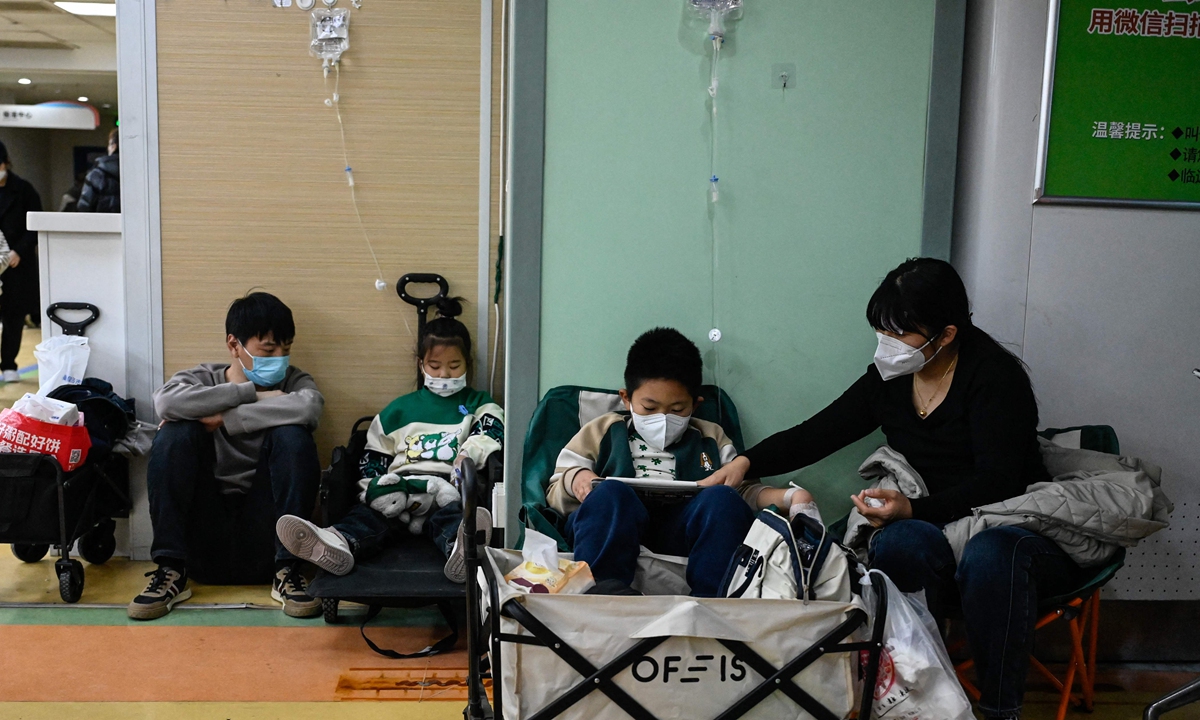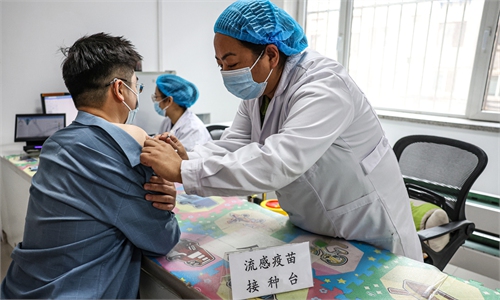Elderly hospitalization peak ‘may come around New Year’s Day’; hospitals optimize resources to support respiratory wards

Sick children receive a drip at a children's hospital in Beijing on November 23, 2023. Photo: VCG.
While the peak of pediatric treatment for influenza and other respiratory diseases has not yet passed, the number of adult patients in emergency rooms and fever clinics is on the rise. Meanwhile, medical experts predict that infections among the elderly will increase by mid-December, when the number of severe cases may increase, and there could be a peak of hospitalization around New Year's Day in 2024.
The Global Times on Monday dialed the appointment hotline of multiple Beijing hospitals such as Peking Union Medical College Hospital, China-Japan Friendship Hospital and the Children's Hospital of the Capital Institute of Pediatrics (Children's Hospital) and found that many pediatric outpatient departments, departments of infectious diseases and respiratory departments are fully booked for the next seven days.
Since late September, the number of children with respiratory infections has gradually increased, and the outpatient receptions at the emergency department of the Children's Hospital have continued to be at a high level, with the highest number of daily receptions being 9,378. In the past two months, the hospital's capacity has reached full capacity, according to local media.
While infections are surging, medical experts expressed their confidence in dealing with the situation as there are adequate medical resources and timely response mechanisms have been optimized, especially since the COVID-19 pandemic.
On Thursday, Chinese authorities told the WHO that the rise in respiratory illness has not resulted in patient loads exceeding hospital capacity.
The Children's Hospital, for instance, has increased infusion seats by 48.7 percent compared with usual numbers. Air purifiers and air conditioners have been installed in observation areas to improve air quality and control temperature. Also, the hospital has increased the number of beds for patients with pneumonia by 40.58 percent, local media reported on Monday.
To cope with the clinic peak, the number of visiting doctors has increased by 86.36 percent. In particular, the hospital has set up refractory pneumonia clinics to ensure medical quality. For critically ill children, the hospital has opened a green channel that gives them priority so they may quickly receive a diagnostic report.
Also the hospital launched an online follow-up clinic for respiratory infections, with the number of internet diagnosis and treatment increasing by 13.36 percent.
In order to alleviate the contradiction between the hospital's capacity and demand, the hospital, along with the Beijing Chaoyang District Maternal and Child Healthcare Center, opened an extra ward at the respiratory department in Chaoyang, and dispatched backbone medical staff. Also, it plans to set up a respiratory tract infection clinic in the district to further spread out patients.
The Global Times learned that some other hospitals also launched similar responses to deal with the surge in respiratory patients.
Media has reported that there have been small outbreaks in families. Some schools across the country have been suspended after multiple students got fevers, according to media reports.
Several senior physicians revealed that the flu is currently one of the major factors contributing to the mounting pressure at emergency departments. Li Tongzeng, the chief physician of the Infection Department at Beijing You'an Hospital, told the Global Times on Monday that it was seeing mostly mycoplasma pneumoniae infections until mid-October. Since mid-November, influenza has increased significantly. Also, there are still many people infected with respiratory syncytial virus and adenovirus.
The flu peak may last another one or two weeks, with children and young people the most affected groups as many of them have to gather together when going to school or work, Li said.
It is expected that by New Year's Day, those groups will have gained immunity from infections, Li said. However, he noted that he is worried that the elderly could be the main group for respiratory diseases during the upcoming New Year's Day holidays as family gatherings surge, thus possibly ushering in another peak for respiratory diseases.
Zhang Zhenhua, director of the Infection Department at the Second Affiliated Hospital of Anhui Medical University, was quoted by a Chinese medical journal as saying that as respiratory viruses spread, the number of elderly infected people will increase by mid-December. Severe infections in this group may also increase, leading to a peak in hospitalization for the group around New Year's Day.
A doctor from a community clinic in the Chaoyang district told the Global Times on Monday that that day alone she received around 100 patients, most elderly residents.
"For patients with fever symptoms, we recommend they be tested for both mycoplasma pneumonia and influenza," said the doctor.
If it is confirmed a patient is infected with the above-mentioned diseases, doctors will keep a record of the patient's personal information, family address and phone number. This information will be reported to local health authorities, said the doctor.
Medical experts suggest that in addition to the elderly and other vulnerable groups, their family members, medical staff as well as nursing home staff should also get flu vaccinations, which can help protect these vulnerable groups.


